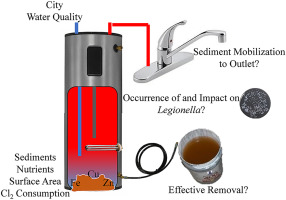当前位置:
X-MOL 学术
›
Water Res.
›
论文详情
Our official English website, www.x-mol.net, welcomes your
feedback! (Note: you will need to create a separate account there.)
Residential water heater cleaning and occurrence of Legionella in Flint, MI.
Water Research ( IF 11.4 ) Pub Date : 2020-01-02 , DOI: 10.1016/j.watres.2019.115439 William J Rhoads 1 , Taylor N Bradley 1 , Anurag Mantha 1 , Lauren Buttling 1 , Tim Keane 2 , Amy Pruden 1 , Marc A Edwards 1
Water Research ( IF 11.4 ) Pub Date : 2020-01-02 , DOI: 10.1016/j.watres.2019.115439 William J Rhoads 1 , Taylor N Bradley 1 , Anurag Mantha 1 , Lauren Buttling 1 , Tim Keane 2 , Amy Pruden 1 , Marc A Edwards 1
Affiliation

|
After the Federal emergency in Flint, MI was declared in early 2016 in response to elevated lead-in-water and incidence of Legionnaires' disease, concerns arose that contaminants in residential water heaters could continue to contribute to poor quality tap water. Here, a comprehensive field survey of residential water heaters (n = 30) and associated water quality was conducted and the subsequent effects of an aggressive manual water heater clean-out was determined, including draining the tank and removing sediments via brushing and flushing. Before cleaning, inorganics accumulated in the tank sediments did not serve as a source of metals measured at hot water outlets. After cleaning, hardness- (calcium, magnesium, silica) and corrosion-associated inorganics (lead, iron, copper, aluminum, zinc) decreased by 64% in samples from sediment cleanout drain valves. Culturable L. pneumophila was only detected in 1 home (3.3%) prior to cleaning and 2 homes (6.7%) after cleaning, thus quantitative polymerase chain reaction was used to quantify potential effects on unculturable strains despite the limitation of differentiating live and dead cells. After the cleaning protocol, Legionella spp. and L. pneumophila gene numbers decreased or remained non-detectable in 83% and 98% of samples, respectively. Homes with less than 0.4 mg/L influent free chlorine tended to have quantifiable Legionella spp. gene numbers in water entering the home and had elevated L. pneumophila and Legionella spp. gene numbers throughout the home plumbing. Also, Legionella spp. and L. pneumophila gene numbers were highest for water heaters set at or below ∼42 °C and significantly decreased >51 °C, consistent with Legionella's preferred temperature range. Examination of the only home that had culturable L. pneumophila both before and after the cleaning protocol revealed that the organism was culturable from several sample locations throughout the home, including in water representative of the water main. Notably, the home was located in close proximity to McLaren Hospital, where an outbreak of Legionnaires disease was reported, and the water heater had a setpoint within the Legionella growth range of 44.2 °C. Considering that other factors were more strongly associated with Legionella occurrence and water heater sediment was not detectably mobilizing to tap water, it was concluded that water heater cleaning had some benefits, but was not an overarching factor contributing to possible human health risks.
中文翻译:

密西根州弗林特的住宅热水器清洁和军团菌的发生。
在2016年初因水铅含量升高和退伍军人病的发病率而宣布在密西西比州弗林特发生联邦紧急情况后,人们开始担心家用热水器中的污染物可能会继续导致劣质的自来水。在这里,对住宅热水器(n = 30)和相关的水质进行了全面的实地调查,并确定了主动手动热水器清洗的后续效果,包括排空水箱并通过刷洗和冲洗去除沉积物。在清洗之前,储罐沉淀物中积累的无机物不能用作热水出口处测得的金属来源。清洁后,硬度(钙,镁,二氧化硅)和与腐蚀有关的无机物(铅,铁,铜,铝,沉积物清除排水阀的样品中的锌含量下降了64%)。尽管在区分活细胞和死细胞方面存在局限性,但仅在清洗前的1个家庭(3.3%)和清洗后的2个家庭(6.7%)中发现了可培养的肺炎支原体,因此定量聚合酶链反应用于量化对不可培养菌株的潜在影响。 。清洁后,军团菌属。肺炎链球菌和肺炎链球菌的基因数量分别减少或保持在83%和98%的样本中无法检测。进水自由氯含量低于0.4 mg / L的房屋往往具有可量化的军团菌属菌种。进入家中的水中的基因数量增加,并且嗜肺乳杆菌和军团菌属物种升高。整个家庭管道中的基因数量。另外,军团菌属。和我。在设定为或低于〜42°C的热水器中,肺炎衣原体的基因数量最高,而在> 51°C时显着下降,与军团菌的首选温度范围相符。在清洁方案之前和之后,对唯一具有可培养的肺炎链球菌培养的房屋进行检查,发现该微生物可在整个房屋的几个样本位置(包括在代表自来水的水中)进行培养。值得注意的是,该房屋位于迈凯轮医院附近,据报道该军团爆发了军团菌病,热水器的设定温度在军团菌的生长范围内为44.2°C。考虑到其他因素与军团菌的发生更密切相关,并且热水器的沉淀物未检测到动员自来水,
更新日期:2020-01-02
中文翻译:

密西根州弗林特的住宅热水器清洁和军团菌的发生。
在2016年初因水铅含量升高和退伍军人病的发病率而宣布在密西西比州弗林特发生联邦紧急情况后,人们开始担心家用热水器中的污染物可能会继续导致劣质的自来水。在这里,对住宅热水器(n = 30)和相关的水质进行了全面的实地调查,并确定了主动手动热水器清洗的后续效果,包括排空水箱并通过刷洗和冲洗去除沉积物。在清洗之前,储罐沉淀物中积累的无机物不能用作热水出口处测得的金属来源。清洁后,硬度(钙,镁,二氧化硅)和与腐蚀有关的无机物(铅,铁,铜,铝,沉积物清除排水阀的样品中的锌含量下降了64%)。尽管在区分活细胞和死细胞方面存在局限性,但仅在清洗前的1个家庭(3.3%)和清洗后的2个家庭(6.7%)中发现了可培养的肺炎支原体,因此定量聚合酶链反应用于量化对不可培养菌株的潜在影响。 。清洁后,军团菌属。肺炎链球菌和肺炎链球菌的基因数量分别减少或保持在83%和98%的样本中无法检测。进水自由氯含量低于0.4 mg / L的房屋往往具有可量化的军团菌属菌种。进入家中的水中的基因数量增加,并且嗜肺乳杆菌和军团菌属物种升高。整个家庭管道中的基因数量。另外,军团菌属。和我。在设定为或低于〜42°C的热水器中,肺炎衣原体的基因数量最高,而在> 51°C时显着下降,与军团菌的首选温度范围相符。在清洁方案之前和之后,对唯一具有可培养的肺炎链球菌培养的房屋进行检查,发现该微生物可在整个房屋的几个样本位置(包括在代表自来水的水中)进行培养。值得注意的是,该房屋位于迈凯轮医院附近,据报道该军团爆发了军团菌病,热水器的设定温度在军团菌的生长范围内为44.2°C。考虑到其他因素与军团菌的发生更密切相关,并且热水器的沉淀物未检测到动员自来水,











































 京公网安备 11010802027423号
京公网安备 11010802027423号